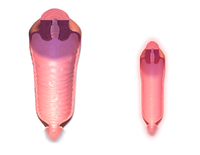
Photo from wikipedia
AbstractBackgroundMagnetic resonance defecography (MRD) allows for dynamic visualisation of the pelvic floor compartments when assessing for pelvic floor dysfunction. Additional benefits over traditional techniques are largely unknown. The aim of… Click to show full abstract
AbstractBackgroundMagnetic resonance defecography (MRD) allows for dynamic visualisation of the pelvic floor compartments when assessing for pelvic floor dysfunction. Additional benefits over traditional techniques are largely unknown. The aim of this study was to compare detection and miss rates of pelvic floor abnormalities with MRD versus clinical examination and traditional fluoroscopic techniques. MethodsA systematic review and meta-analysis was conducted in accordance with recommendations from the Preferred Reporting Items for Systematic Reviews and Meta-Analyses. MEDLINE, Embase and the Cochrane Central Register of Controlled Trials were accessed. Studies were included if they reported detection rates of at least one outcome of interest with MRD versus EITHER clinical examination AND/OR fluoroscopic techniques within the same cohort of patients. ResultsTwenty-eight studies were included: 14 studies compared clinical examination to MRD, and 16 compared fluoroscopic techniques to MRD. Detection and miss rates with MRD were not significantly different from clinical examination findings for any outcome except enterocele, where MRD had a higher detection rate (37.16% with MRD vs 25.08%; OR 2.23, 95% CI 1.21–4.11, p = 0.010) and lower miss rates (1.20 vs 37.35%; OR 0.05, 95% CI 0.01–0.20, p = 0.0001) compared to clinical examination. However, compared to fluoroscopy, MRD had a lower detection rate for rectoceles (61.84 vs 73.68%; OR 0.48 95% CI 0.30–0.76, p = 0.002) rectoanal intussusception (37.91 vs 57.14%; OR 0.32, 95% CI 0.16–0.66, p = 0.002) and perineal descent (52.29 vs 74.51%; OR 0.36, 95% CI 0.17–0.74, p = 0.006). Miss rates of MRD were also higher compared to fluoroscopy for rectoceles (15.96 vs 0%; OR 15.74, 95% CI 5.34–46.40, p < 0.00001), intussusception (36.11 vs 3.70%; OR 10.52, 95% CI 3.25–34.03, p = 0.0001) and perineal descent (32.11 vs 0.92%; OR 12.30, 95% CI 3.38–44.76, p = 0.0001). ConclusionsMRD has a role in the assessment of pelvic floor dysfunction. However, clinicians need to be mindful of the risk of underdiagnosis and consider the use of additional imaging.
Journal Title: Techniques in Coloproctology
Year Published: 2017
Link to full text (if available)
Share on Social Media: Sign Up to like & get
recommendations!